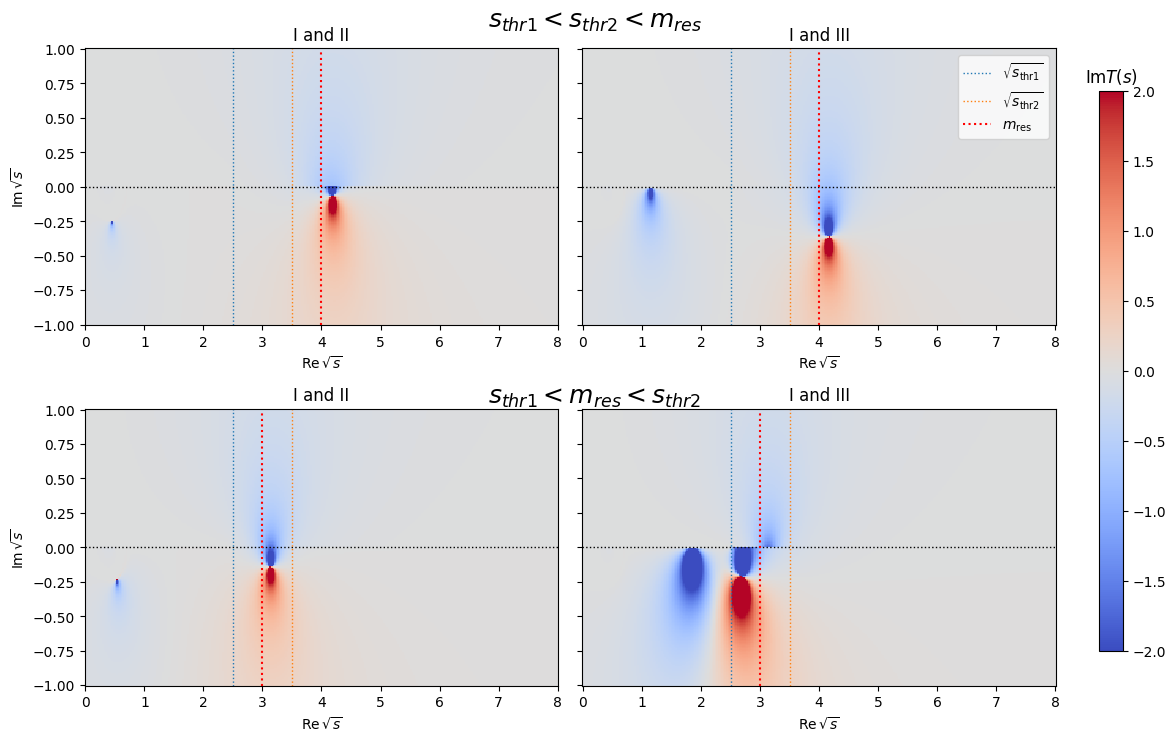Coupled channel Riemann sheets#
Expression definitions#
Riemann sheet I#
Matrix definition#
T_I = (I - sp.I * K * CM).inv() * K
T_I
T_I_explicit = T_I.as_explicit()
T_I_explicit[0, 0].simplify(doit=False)
Parametrization#
T_I_cm_expr = T_I_explicit.xreplace(cm_expressions)
T_I_cm_expr[0, 0].simplify(doit=False)
Sheets II, III, and IV#
In the case of two channels, there are four Riemann sheets. The first sheet (Sheet I) is physical and three unphysical ones. The physical sheet is calculated using the analytic solution of the Chew-Mandelstam function.
Depending on the centre-of-mass energy, different Riemann sheets connect smoothly to the physical one. Therefore, two cases are studied: one where the resonance mass is above the threshold of the second and first channel, and another where the resonance mass is between the threshold of the first and second channel.
T_II_explicit = T_II.as_explicit()
T_II_explicit[0, 0].simplify(doit=False)
T_III_explicit = T_III.as_explicit()
T_III_explicit[0, 0].simplify(doit=False)
T_IV_explicit = T_IV.as_explicit()
T_IV_explicit[0, 0].simplify(doit=False)
rho_expressions_II = {
**cm_expressions,
rho[0, 0]: PhaseSpaceFactor(s, ma1, mb1),
rho[1, 1]: 0,
}
rho_expressions_III = {
**cm_expressions,
rho[0, 0]: PhaseSpaceFactor(s, ma1, mb1),
rho[1, 1]: PhaseSpaceFactor(s, ma2, mb2),
}
rho_expressions_IV = {
**cm_expressions,
rho[0, 0]: 0,
rho[1, 1]: PhaseSpaceFactor(s, ma2, mb2),
}
# @title
T_II_rho_expr = T_II_explicit.xreplace(rho_expressions_II)
T_III_rho_expr = T_III_explicit.xreplace(rho_expressions_III)
T_IV_rho_expr = T_IV_explicit.xreplace(rho_expressions_IV)
T_II_rho_expr[0, 0].simplify(doit=False)
T_III_rho_expr[0, 0].simplify(doit=False)
Visualizations#
Lineshapes (real axis)#
Complex plane (2D)#
It can be shown that if the resonance mass is above both thresholds the third sheet connects smoothly to the first sheet. If the resonance mass is above the first and below the second threshold the second sheet transitions smoothly into the first sheet.




